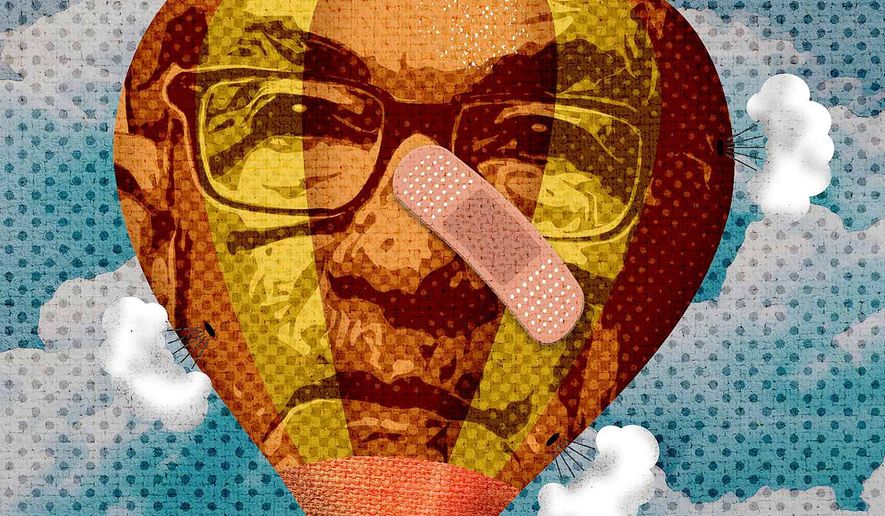OPINION:
Inflation is proving one tough dragon to slay.
A Federal Reserve infected by pseudoeconomics and a profligate Biden administration are imposing a trifecta of pain: inflation well above the Fed’s 2% target, high interest rates and falling living standards.
COVID-induced supply chain disruptions can be blamed for about half the surge in inflation that began in 2021 as the economy reopened.
The other half can be laid at the feet of the $4.6 trillion in emergency aid and stimulus spending, especially the final tranche — President Biden’s $1.9 trillion American Rescue Plan — which was criticized even by some liberal economists.
That spending required a huge jump in federal debt and to keep interest rates from skyrocketing, the Fed dramatically increased its balance sheet. That’s econspeak for creating money out of thin air in the cosseted confines of the Fed’s Constitution Avenue cloister.
Federal Reserve Chairman Jerome Powell told us that printing money doesn’t cause inflation in 2021, but it peaked at 8.9% in June 2022.
The Fed was slow to act.
Mr. Biden delayed reappointing Mr. Powell as the end of his term approached. Mr. Powell responded like any Washington swamp creature by telling us the inflation was transitory.
Since those fairy-tale days, China’s factories have reopened, West Coast ports have solved labor problems and ocean shipping rates have eased.
Ultimately, the Fed raised interest rates from near zero to just above 5%. As importantly, it has been reducing the size of its balance sheet and the money supply — but too slowly.
From the fourth quarter of 2019 to the first quarter of 2023, real gross domestic product recovered and was up 5.6%. The money supply as measured by currency in circulation, household and business checking accounts and money market deposits was still up 38.7% — a difference of over 33 percentage points.
We’re darn lucky that prices jumped only 16.8%.
The Fed will likely raise the benchmark overnight lending rate for banks by half a point by the end of this year. And it continues to run down its balance sheet and the money supply, but the pace is still painfully slow.
Looking over the horizon, the Fed may get some reprieve as falling rents work into the consumer price index — the cost of shelter is its largest component — but enormous caution is warranted.
The Great Inflation that Paul Volcker slew in the early 1980s was a decade and a half in the making.
Inflation peaked in 1966, 1970 and 1974 at 3.8%, 6.4% and 12.1%. Each time, the Fed was raising rates to curb inflation but pulled back to stave off a weakening economy. Ultimately, inflation rose to 14.6% in early 1980.
Now the U.S. and European economies are slowing again. Limiting interest rate increases may be enough to rescue the U.S. economy from a recession, but that could prove a tragic mistake.
Apologists for printing press monetary policy, who once hectored from the gallery, are now inside the Fed’s policymaking committee.
As the Fed hesitates on interest rates in search of a soft landing — much in the manner of weak-kneed Fed policy in the 1960s and 1970s, Chicago Fed President Austan Goolsbee, a Biden appointee, suggests that “mocking the immaculate deflation is a mistake because there was a large component that was immaculate inflation.”
That’s heresy for a University of Chicago economist. The Fed boosting the money supply by 39% makes the paternity of inflation no mystery.
Mr. Biden’s infrastructure, CHIPS and Science, and Inflation Reduction acts will increase the federal deficit from $984 billion in 2019 to $1.5 trillion this year and next.
The transition to electric vehicles will dramatically raise new car prices, the slowdown in home construction during COVID and rising interest rates will impose a tighter housing market in 2024, and rising temperatures and drought will continue to pressure food prices.
In just one example, beef prices are headed north as parched grazing land and the high cost of feed are forcing cattlemen to reduce herd sizes.
Progressives are looking for a scapegoat in place of easy money. For example, profiteering by food and consumer product companies that they’d like to tax.
But the structure of those industries has not changed much since Mr. Biden was inaugurated. Why are those monopolists so powerful now but were so weak when Donald Trump was president, growth was stronger and inflation less.
Either the Fed raises interest rates a lot further and the country risks a Volckeresque recession, or inflation may abate for a time but then soar again.
And it won’t be good for workers.
In eight of the first nine quarters of the Biden presidency, wages were up less than inflation. That gives Mr. Biden a 0.111 batting average — well below the dreaded Mendoza line.
In baseball, a player would be sent to the minors, unless he’s too old — then he’d be retired.
Peter Morici is an economist and emeritus business professor at the University of Maryland, and a national columnist.




Please read our comment policy before commenting.